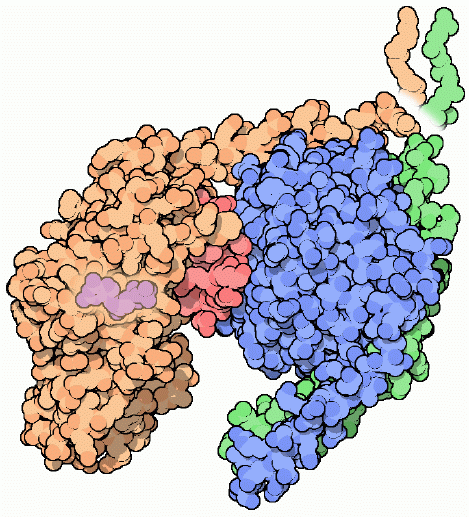|
Inhaltsübersicht | Nanomaschinen | Moleküle | Programme | Kurse | Fun | Links |
||
| > |
G Proteins
G Proteins
Cells communicate by passing small, disposable messages to one another. Some of these messengers travel to distant parts of the body through the blood, others simply diffuse over to a neighboring cell. Then, another cell picks the message up and reads it. Thousands of these messages are used in the human body. Some familiar examples include adrenaline, which controls the level of excitement, glucagon, which carries messages about blood sugar levels, histamine, which signals tissue damage, and dopamine, which relays messages in the nervous system.Reading the Mail
In many cases, these molecular messengers never get inside cells. Instead, the message is picked up by a receptor on the cell surface and the signal is then passed from outside to inside through a chain of signaling molecules. G proteins, such as the one shown here from PDB entry 1gg2, form the central link in this chain of communication. The G protein system is the most common method of signaling in our cells. Thousands of G-protein-coupled receptors have been found on our cells, each waiting for its own particular messenger. Some recognize hormones and make changes in the level of metabolism. Others are used in the nervous system to transmit nerve signals. Our sense of sight also relies on a G protein system that is sensitive to light, and a thousand different forms of these receptors, each recognizing the odor of a different molecule, control our sense of smell. They all share the combination of a receptor that receives a message and a G protein that delivers it inside the cell.The "G" in G Proteins
G proteins are molecular switches that use GDP (colored purple here) to control their signaling cycle. When GDP is bound, as shown here, the G protein is inactive. To activate the protein, the GDP is replaced with GTP, the G protein will deliver its signal, as shown on the next page. G proteins come in many shapes and sizes. Most are used for cell signaling, but other types play an important role in other tasks, such as powering protein synthesis. The ones described here are termed heterotrimeric G proteins because they are composed of three different chains, denoted as alpha (tan), beta (blue), and gamma (green). The little red piece is a loop on the surface of the alpha subunit that is important in transmitting the signal.Hugging the Membrane
These G proteins bind to the inner surface of the cell membrane, holding them close to their receptors. Several small lipids are attached to the protein chains (as seen at the upper right in the picture), which insert into the membrane and tether the protein there. However, don't try to find these little lipids in the crystal structure file, because they were removed to allow crystallization.G Proteins Under Attack
The G protein system plays a central role in many signaling tasks, making it a sensitive target for drugs and toxins. Many of the drugs that are currently on the market, such as Claritin and Prozac, as well as a number of drugs of abuse, such as heroin, cocaine and marijuana, act at G-protein-coupled receptors in these signaling chains. Cholera bacteria make a toxin that attacks G proteins directly, by attaching a nucleoside group in a strategic place. This modification causes the G protein to be continually active. Among other things, this disrupts the normal controls on fluid balance in intestinal cells, and the infected person rapidly becomes dehydrated as water, sodium and chloride are lost.
For more information on G proteins from a genomic persective, take a look at the Protein of the Month at the European Bioinformatics Institute.
Next: Relaying the Signal
Last changed by: A.Honegger,
